If you are an avid reloader of pistol ammunition, you are probably a little spoiled. Thanks to progressive loading machines, spent pistol cases can be deprimed, resized, and belled at the case mouth one after another, just by working a single lever. Preparing rifle cases for reloading is far more tedious, with each spent case demanding not only resizing in terms of diameters but also a return to specified length by trimming the edges of the case mouth, followed by chamfering of the case mouth interior and a cleaning of the primer pocket. Each of these operations touches upon the skills of a machinist or perhaps a tool-and-die maker. As such, we decided to look at some machines that automate the case-preparation process.
When we use the word “automated,” we don’t really mean it in the truest sense of the word. Case “prep” stations do not enable you to pop a spent shell into one side of the machine and retrieve a fully prepared case from the other. What these machines do is offer a measure of precision and provide the elbow grease for getting the job done. To find out how much help a case-prep station can be, we shopped Brownells.com and its sister company Sinclair International (SinclairIntl.com). We walked away with a $135 Lyman Case Prep Xpress and two RCBS products, the RCBS Trim Mate Case Prep Center ($130) and the $400 Universal Case Prep Center. We also acquired a $200 Frankford Arsenal Platinum series Case Trim and Prep Center. Of the four, only the Frankford Arsenal and the RCBS Universal provided a case-trim feature.
Our test cartridge cases were Hornady 6.5 Creedmoor brass left over from recent tests that had been sized and deprimed on our MEC Marksman press (see the March 2017 issue). The fired cases measured about 1.92 inches in length or more. Our goal was to size the empty cases to as close to 1.91 inches as we could get. Consistent results were what we were after, but convenience and ease of operation would be good reasons to buy a case-prep station, too. Durability and ease of cleanup are additional considerations, but we had to ask, would the skills of a professional machinist be necessary to produce the best results? Or could anyone turn a used case into a match-ready component? Let’s find out.
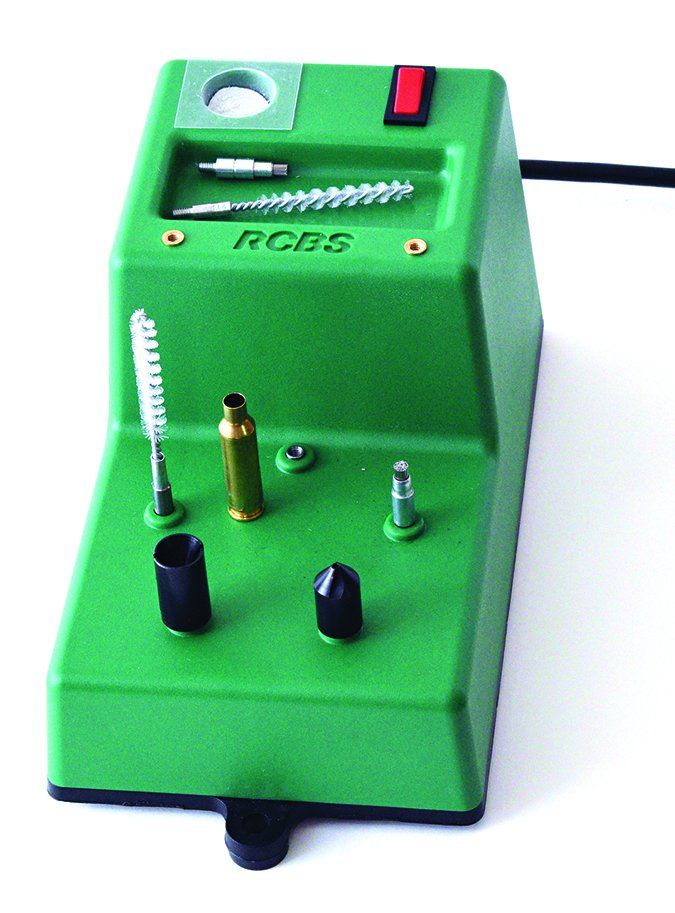
RCBS Trim Mate Case Prep Center, $130
The RCBS Trim Mate is so named because it is to be used after completing the trimming process. The Trim Mate took up bench space measuring about 5.5 inches wide by 11 inches deep. Resembling a stepstool, the upper rearward portion was dished to hold alternate tools or cartridge cases. There was also a small well for powdered case-neck lubricant. The lower level offered five workstations, each of them rotating at the same speed when power was turned on. Tools for primer-pocket cleaning, case-mouth chamfering, case-exterior deburring, and brushing out the interior of the case neck were mounted vertically. The fifth station was left empty for optional accessories sold separately, such as a primer-pocket uniformer and a military-crimp remover. A military-crimp remover is useful whenever cases are culled from surplus ammunition, which typically features crimped primer pockets that must be processed. The chamfering and deburring tools were already in place at the front of the lower level, but the position of the tools could be changed to suit the operator.
When it comes to spending more than $100, it would have been nice to include a case-trimming station. Then again, trimming to length is the critical operation, and many reloaders might rather utilize a separate, dedicated machine, whether it was motor driven or hand cranked. The deburring tool was smooth and efficient and the case neck brush was handy, too. The chamfering tool introduced a steep angle so the resulting chamfer tended to be to brief and narrow. While this does limit how much the case mouth is thinned, some reloaders may prefer a longer more gradual slope to guide the new bullet into place. We had no way of containing the dry lube after it was open, so we might choose another product for this function. While there weren’t any guides to help index the cases on the centerline of each tool, applying pressure vertically was easy. Holding each case with the side of the hand or base of the palm on the surface of the machine was helpful.
Our Team Said: The Trim Mate did an excellent job of cleaning the primer pocket, and quickly, too. We think this machine would be a good choice for anyone who regularly processes surplus brass, wherein removing the military crimp at the primer pocket is critical and generally time consuming.
GUN TESTS GRADE: B+
Lyman Case Prep Xpress, $135
The Lyman Case Prep Xpress, like the RCBS Trim Mate, focuses on refinishing the case after the case mouth has been trimmed. The Xpress took up a squared section of our bench 9 inches across by about 10 inches deep. The actual workspace was a circle offering five stations that rotate simultaneously when the power is switched on. The power cord was heavy duty and removable. Six threaded-brass bushings for keeping the tools handy were provided as well. The selection of tools was more complete than the Trim Mate’s starter set, including a closeable plastic cup filled with Lyman dry case-neck lube and a stiff-bristled brush for cleaning the tools. There was a long spire-shaped chamfering tool and an outside deburring tool. Four different-size nylon case-neck brushes were supplied: large and small primer-pocket reamers, large and small primer-pocket uniformers, and a pair of large and small primer-pocket cleaners.
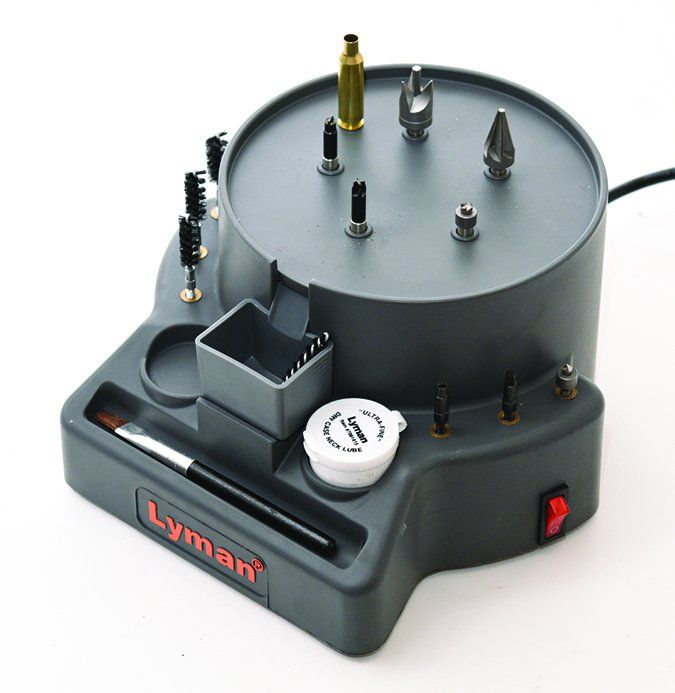
We really liked the quality of the chamfering and case-mouth deburring tools. Given its steep conical shape, we expected a deeper chamfer in response to downward pressure to appear very quickly. But it was surprisingly progressive, so if we wanted just a brief angling of the interior, we could achieve that, and if we wanted to go deeper, it was just a matter of time and patience. The wide selection of case-neck brushes was a plus, and the primer-pocket uniformers and reamers were very effective and performed smoothly. But we didn’t like the supplied tools for cleaning the primer pocket. They seemed too aggressive in contact with the inner walls of the primer pocket, yet didn’t seem that effective or efficient in removing debris from the area surrounding the flash hole. The extra drag caused us to wobble, and it seemed we were fighting to keep the cartridge case straight up and down as we worked.
Our Team Said: Overall, we liked the unit, but would look for alternate tools heads for servicing the primer pockets.
GUN TESTS GRADE: B+
RCBS Universal Case Prep Center, $420
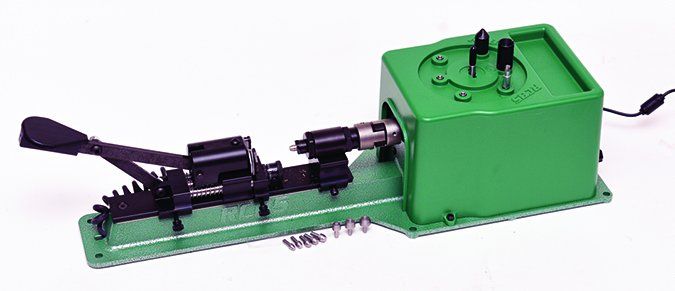
The RCBS Universal Case Prep Center combines a six-station work center with a case-trimming lathe. The entire unit measures about 20.5 inches long by 6.5 inches deep and should be hard mounted with the long side parallel to the front of the bench to ensure proper access to the lathe. The unit could be mounted with the lathe to the left or right to suit both left- and right-handed users. Turn on the power, and the case-mouth cutter spins along with all six stations. Tools provided for the stations located on the upper platform included a case-neck deburring tool, case-mouth chamfering tool, and both large and small primer-pocket brushes with steel bristles. Case-neck brushes were not provided. The only assembly required was mounting the handle lever that opened the jaws of the case holder in preparation for trimming.
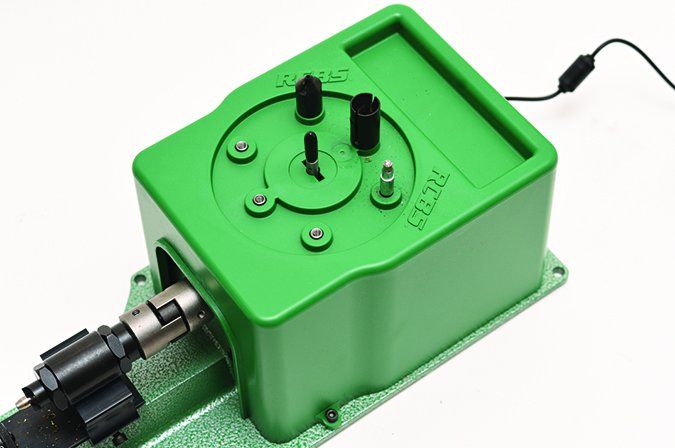
The speed at which the tools spin was controlled by a rheostat. From a “click” on/off position, the more you rotated the dial, the faster the tools rotated. Two safety features applied. First, there is a lockout feature that prevents the toolheads from spinning with the power on so you can concentrate on case trimming. And each time you press down on the lever to back off the case carrier from the cutter, the power is shut off and all tool heads stop spinning.
Setting up the lathe for case trimming began with choosing the proper pilot. The pilot slipped into the center of the case-trimming tool, acting as a guide for the case neck so that the edge of the case mouth was presented at a 90-degree angle to the cutting surfaces. A selection of nine different pilots ranging in caliber from 22 to 45 was provided. The tip of each pilot was flat and marked with the appropriate caliber.
Whereas the rotating cutting blades remained stationary, the case was brought to the cutters in a two-step process. First, the case was held in a jig referred to as the Shell Holder Carrier assembly that rode on a track bringing it up to the case trimmer. Before settling on any adjustment, we locked down the carrier well back from the cutter by tightening the two knurled thumbscrews. Then we pressed down on the handle to open the jaws of the shell holder and inserted the case to be trimmed. We loosened the thumbscrews and moved the carrier until the case mouth was up against the trimmer. We locked down the carrier by tightening the thumb screws. In Step 2, we used the calibrated micrometer mounted on the carrier to keep track of how much we shortened the case. We turned the micrometer counter-clockwise, pressing the case mouth against the cutter, thereby shortening the case. Turning up the pressure a little at a time, we shortened the case to our desired specifications. Now that we had established our start position, pressing down on the handle allowed us to insert and remove the cases without changing the position of the carrier.
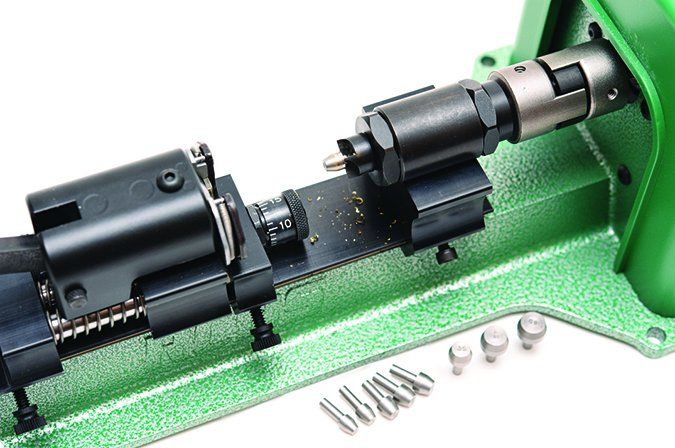
To find out how consistent and accurate the trimming system was, we fully processed 10 cases and measured them with a caliper. Seven of the resulting ten cases measured 1.911 inches in length with the remaining three cases each measuring 1.912 in long.
The deburring tool worked quite well, and the scrubbing action of the steel wire brush was very efficient in cleaning the primer pocket. The chamfering tool required some effort and produced a thin slope inside the case. Bullets with a more linear profile may require more chamfering. We liked the lockout feature that stopped the tools on the upper platform from rotating because working the handle to mount the case does require some manhandling and the extra tools whirring away next to our elbow might give pause. Having to guide the case mouth onto the pilot was perhaps the only glaring weakness of the Universal because the auto-stop feature did not keep the cutter from beginning to rotate once the case mouth approached the tip of the pilot. It was safer, and more tedious, to turn the machine off and on between loading cases. In terms of adjustment, we’d like to have a zero marking on the micrometer to help keep track of how many clicks we had moved from one adjustment to the other. We scratched a line on the micrometer body and found that each click shortened our 6.5CM cases about 0.012 inches.
Our Team Said: Results from case to case were remarkably consistent. The RCBS Universal Case Prep Center offered the sensation of manning our own miniature machine shop.
GUN TESTS GRADE: A-
Frankford Arsenal Platinum Series Case Trim and Prep Center, $200
The Frankford Arsenal Platinum series Case Trim and Prep Center is a compact unit that only took up a rectangular section of our workbench measuring about 7 inches wide and about 11.75 inches deep. All the tool heads face front and are backed by an electric motor that spins the trimmer assembly, case-chamfering tool, case-mouth deburring tool (which Frankford Arsenal refers to as an outside chamfer tool), and primer-pocket cleaner. The housing for the electric motor is topped with a storage box for bushings, collets, and cutters. The on/off switch was located on the right side of the unit at the rearmost edge. If the location of the tool heads facing front sounds awkward, this concern was addressed by providing an adjustable stand that lifted the front end about 2 inches, resulting in a very usable orientation. As such, the cases are applied to the tool head in a slightly downward direction.
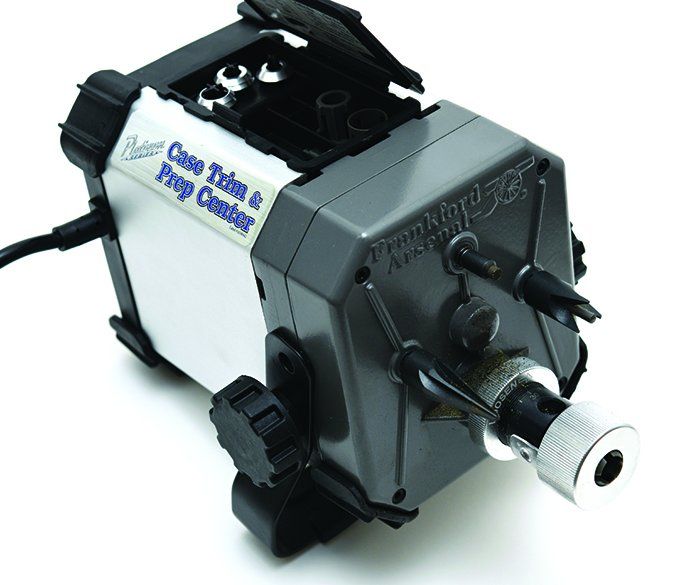
The chamfer tool was sharply spire pointed and produced a deep chamfer. The deburring tool was fast and efficient. The primer-pocket cleaner had very small black bristles, lending it the appearance of being a solid post. It reminded us of a small pencil eraser. We found that rotating the case in the direction opposite to the spinning pocket cleaner and moving it around slightly sped up the cleaning process.
Whereas the RCBS Universal offered a lathe system to trim cases, the Platinum utilized collets and bushings that align the case and limit its forward movement inside the trim-cutter assembly. The first step was to choose the correct size collet and the proper bushing, which surrounds the case shoulder to hold the case steady at a 90-degree angle to the cutting surface. Small, medium, and large case-body collets were provided to fit calibers 223 Rem., 308 Win./30-06, and magnum-size cases, respectively. Six different-size shoulder bushings were provided, ranging in size from 0.27 inches to 0.49 inches to suit a range of calibers from 17 to 458. Together, the bushings and collets held the cases firmly to provide a measure of trim-length adjustment by limiting how far each case can be pushed against the cutting surface. The case-holder assembly was then rotated in or out to press the case mouth against the cutting surface. The combination of the collets, bushings, and the case-holder assembly sets the amount of material removed from the case mouth and therefore controls case length. Like the RCBS Universal, there wasn’t a dedicated zero marking to keep track of settings. Whereas we scribed a sloppy line into the housing of the Universal’s calibration wheel, the only available structure available for marking was the case-holder lock nut. Realizing that the case-holder lock nut would be rotated each time we changed calibers, we didn’t bother with marking a visual calibration beyond noticing what number on the case holder body was facing 12 o’clock. Whereas case length, that is, just how much material was removed, was controlled by turning the collet adjustment cap. The only way to be sure we were generating the length we wanted was to cut a little at a time and measure case length with a caliper.
Once we installed the proper collet and bushing, we realized that the case was indeed held firmly at a 90-degree angle to the cutting surface. We pressed the case in toward the cutter until we felt the pressure wane. Then we removed the case, chamfered the interior case mouth, and deburred the exterior. Out of ten cases trimmed, we found seven cases that measured 1.9105 inches in length, two at 1.9100 inches, and one measuring 1.92 inches long. We decided to take the longest case and press it into the trimmer as hard as we could. This resulted in a trimmed length of 1.857 inches, still usable.
Our Team Said: Did we need the skills of a machinist to operate this machine? Just one: Knowing when to stop applying pressure. The key was to let the bushings and collets do all the work. We liked how compact the Platinum unit was, and it was portable, too. The integral toolbox for extra heads and fittings was a big plus. We liked being able to trim the case safely and move on to the other prep features all in one area. The primer-pocket cleaner was less efficient than the other machines, in our view, but we could trim as well as chamfer and deburr in about the same time it took the other machines to chamfer and deburr. While trim-length adjustment was not precisely calibrated, once the setting was established, the results were very consistent.
GUN TESTS GRADE: A-
Written and photographed by Roger Eckstine.


























